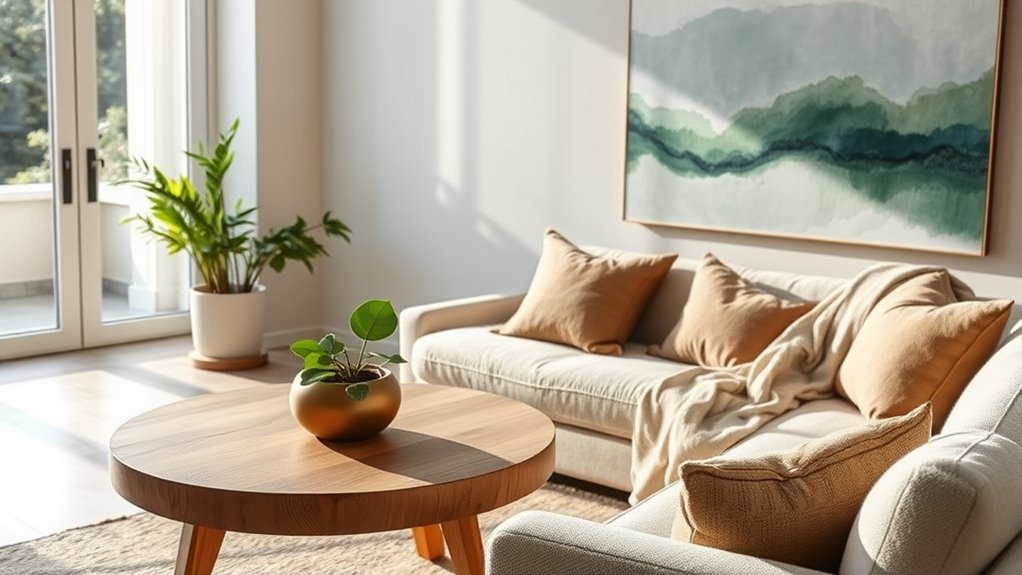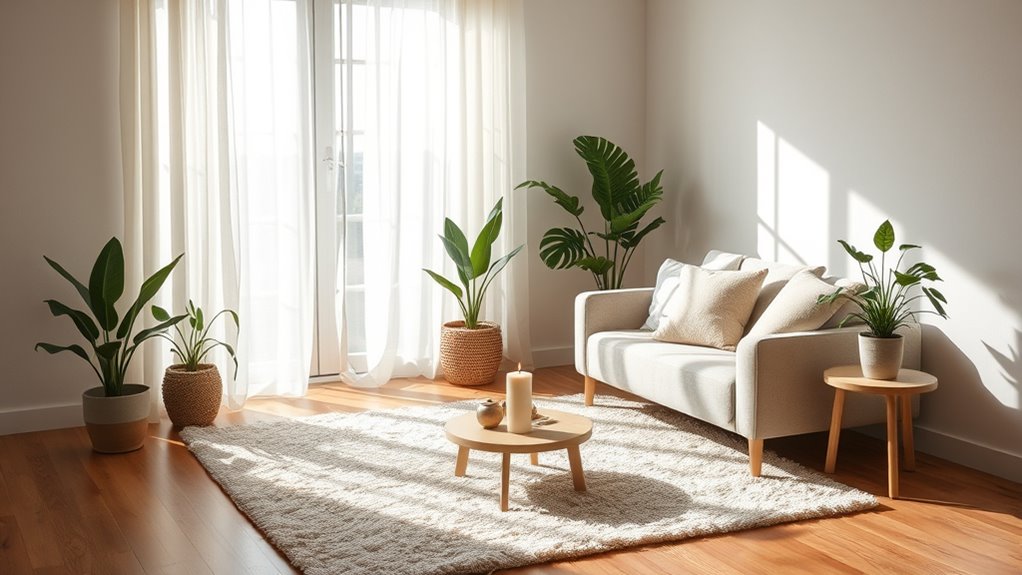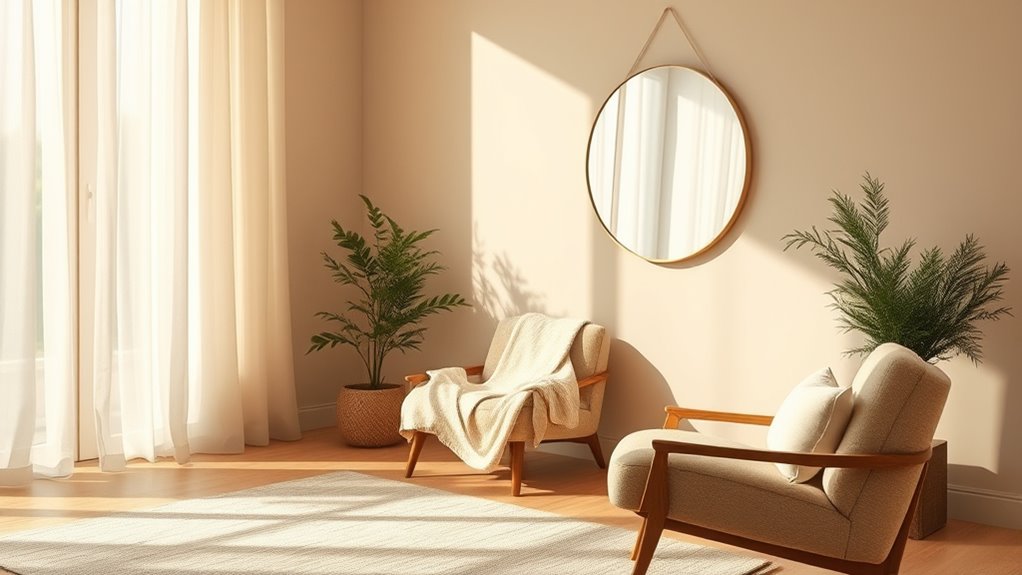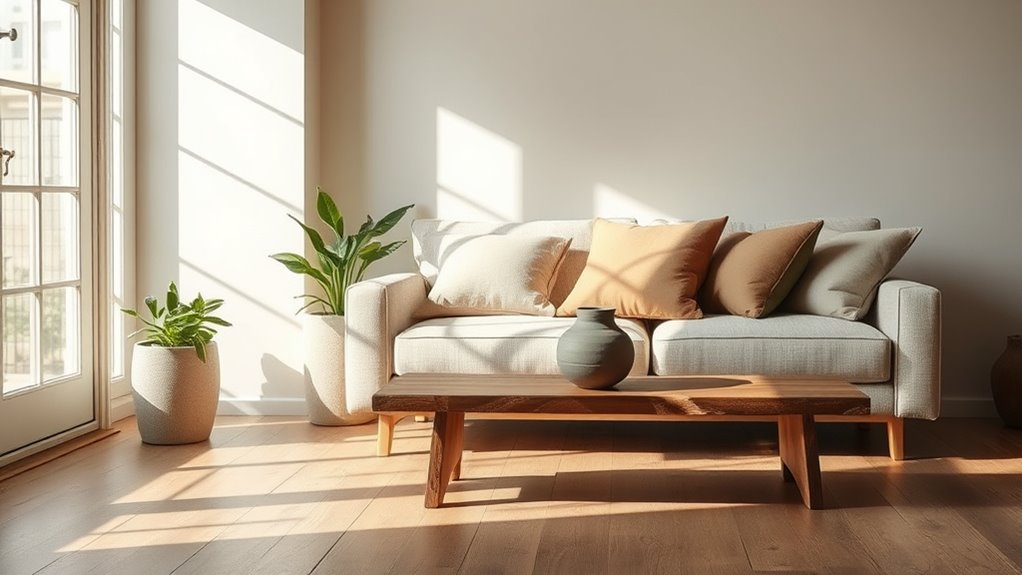As an interior designer, you should embrace mindfulness to create tranquil and inviting spaces. Focus on natural materials like wood and stone, and use soft, natural light to enhance calmness. Incorporating biophilic elements, such as indoor plants and water features, can improve well-being. Prioritize minimalist designs with clean lines to reduce stress and promote clarity. By implementing these strategies, you can foster emotional regulation in your clients. There’s much more to explore about mindful design practices.
Key Takeaways
- Incorporate natural materials and indoor plants to enhance tranquility and foster a connection with nature in interior spaces.
- Embrace minimalism by using simple shapes and muted colors to create a calming and inviting atmosphere.
- Design dedicated quiet zones for mindfulness practices, promoting relaxation and deeper connections with the environment.
- Maximize natural light and utilize soft lighting to enhance mood and focus in living and working spaces.
- Create open layouts that support easy movement and visual harmony, reducing stress and promoting clarity.
Embracing Present Moment Awareness in Design

How can you bring present moment awareness into your design process? Start by focusing on the materials you choose. Opt for natural elements like wood and stone that ground your space and promote a sense of calm.
Embrace minimalism; use simple shapes and muted colors to create an inviting atmosphere. Designate quiet zones for meditation or relaxation, encouraging users to connect deeply with their environment.
Pay attention to lighting; soft, natural light can enhance tranquility and focus. Finally, ensure your spaces are clean and organized, which supports mindfulness. Additionally, incorporating natural elements into your design can significantly promote tranquility and create a serene atmosphere.
Integrating Biophilic Elements for Enhanced Well-being

Incorporating biophilic elements into your design not only beautifies a space but also significantly enhances well-being. By using natural materials like wood, stone, and cork, you evoke a sense of nature that promotes emotional well-being.
Adding indoor plants improves air quality and fosters relaxation. Consider including water features, like fountains, to create a soothing atmosphere. Maximize natural light to boost mood and productivity, while textured materials engage the sense of touch.
These elements help reduce stress, enhance focus, and even improve cognitive function. Ultimately, integrating biophilic design supports both physical and mental health, making your spaces not just visually appealing but also nurturing for those who inhabit them. Additionally, incorporating natural materials like stone and wood can further enhance the tranquility of the environment.
Strategies for Creating Mindful Interior Spaces

Creating mindful interior spaces involves thoughtful consideration of layout, materials, and ambiance. Start by prioritizing open spaces that promote calm and clarity, adopting a minimalist style to keep only essentials.
Design flowing layouts that allow easy movement, reducing stress. Aim for visual harmony by minimizing divisions and maximizing natural light.
Incorporate natural fabrics like wood and stone, adding indoor plants for vitality and air purification. Choose earthy tones for a calming atmosphere and select soothing color palettes to encourage relaxation.
Implement layered lighting for customizable ambiance, utilizing dim options to enhance introspection. Finally, create dedicated areas for mindfulness practices and limit technology distractions, fostering a deeper connection with your surroundings and enhancing overall well-being. Additionally, consider using natural fabrics that are not only aesthetically pleasing but also contribute to a healthier indoor environment.
The Impact of Mindfulness on Emotional Regulation

Mindfulness profoundly influences emotional regulation, offering you tools to navigate your feelings with greater ease.
Neuroimaging studies reveal that mindfulness practices can lead to structural and functional changes in brain areas linked to attention and emotion regulation.
By enhancing your attention control and self-awareness, mindfulness helps you observe experiences without judgment or reactivity. This non-judging approach allows you to accept and clarify your internal experiences, reducing emotional dysregulation.
Even brief mindfulness interventions can significantly improve your emotional regulation abilities.
As you practice mindfulness, you’ll find a decrease in the intensity of negative emotions and a greater capacity for cognitive reappraisal, ultimately leading to a more balanced emotional state in your personal and professional life as an interior designer.
Future Directions in Mindful Interior Design Practices

As the world of interior design continues to evolve, you’ll find that future trends increasingly embrace mindfulness principles.
Expect to see a greater emphasis on natural elements, like wood and plants, which foster a harmonious atmosphere. Biophilic design will thrive, incorporating nature-inspired patterns that enhance well-being.
A focus on natural elements and biophilic design will create harmonious spaces that enhance well-being and foster connection with nature.
You’ll notice a shift towards minimalism, focusing on essential items to reduce clutter. Sustainable practices will gain traction, using eco-friendly materials and promoting slow decorating for quality over quantity.
Additionally, smart home integration will balance technology with mindfulness, creating digital detox zones.
As urban living spaces become more compact, designs will prioritize well-being and community interaction, ensuring that mindfulness remains at the forefront of your design journey. Incorporating natural materials like wood will further enhance the connection between indoor spaces and the natural world.
Frequently Asked Questions
How Can I Incorporate Mindfulness Practices Into My Daily Design Routine?
To incorporate mindfulness practices into your daily design routine, start by dedicating a few minutes each morning to mindful breathing.
Throughout the day, take short breaks to notice the details around you, sparking creativity.
Engage fully with your clients by practicing mindful listening.
In the evening, reflect on your accomplishments and challenges to foster growth.
What Are Some Examples of Mindful Design in Commercial Spaces?
Incorporating mindful design in commercial spaces can transform the environment significantly. You can use natural light to boost mood and focus, while adding plants for improved air quality and a calming atmosphere.
Consider using natural materials like wood and stone to connect with nature. Create flexible workspaces that cater to different needs, and maintain a clutter-free environment to minimize distractions.
Lastly, implement adjustable lighting and sound masking techniques to enhance overall mindfulness.
How Do I Choose the Right Colors for a Mindful Environment?
To choose the right colors for a mindful environment, start by visualizing how each hue affects mood. Soft blues and gentle greens evoke calmness, while warm yellows can energize.
Think about the space’s purpose—relaxation or productivity—and select colors that enhance that vibe. Balance is key; use neutrals to ground vibrant accents.
Don’t forget to consider lighting, as it can dramatically change your color perception and overall atmosphere.
Can Mindfulness Improve Client-Designer Communication?
Absolutely, mindfulness can significantly improve client-designer communication.
By being fully present, you listen more attentively to your client’s needs, leading to clearer conversations. Practicing non-judgment helps you engage with their ideas without bias, fostering trust.
You’ll notice increased emotional intelligence, enabling you to understand their feelings better. This open and empathetic approach creates a respectful dialogue, ensuring all feedback is valued, which ultimately enhances the overall communication experience.
What Resources Are Available for Further Learning About Mindful Design?
Think of resources as your treasure map to mindful design!
You’ve got a variety of options at your fingertips. Dive into research papers that explore mindfulness in design, attend workshops that cultivate compassion, or explore design pedagogies that integrate mindfulness.
Reflective practices can enhance your learning, and case studies offer real-world insights. Each resource brings you closer to creating spaces that resonate with well-being and awareness.
Start your journey today!
Conclusion
Incorporating mindfulness into your interior design practice can transform your spaces into sanctuaries of serenity. By embracing present moment awareness, integrating biophilic elements, and employing mindful strategies, you’re not just creating beautiful environments; you’re crafting havens that nurture the soul. Imagine walking into a room that feels like a gentle hug, wrapping you in warmth and tranquility. As you move forward, let mindfulness guide your designs, creating spaces that uplift and inspire everyone who enters.










